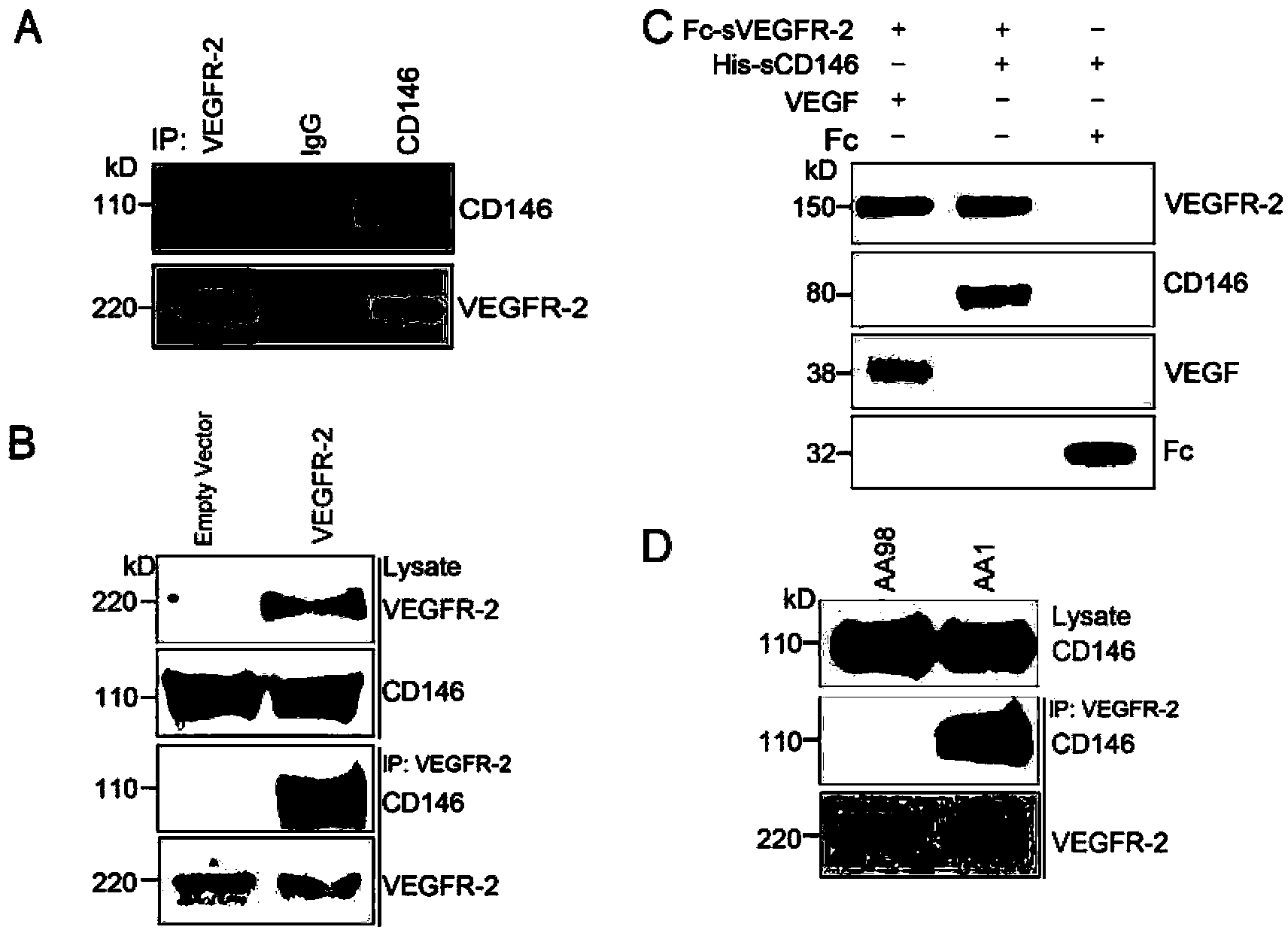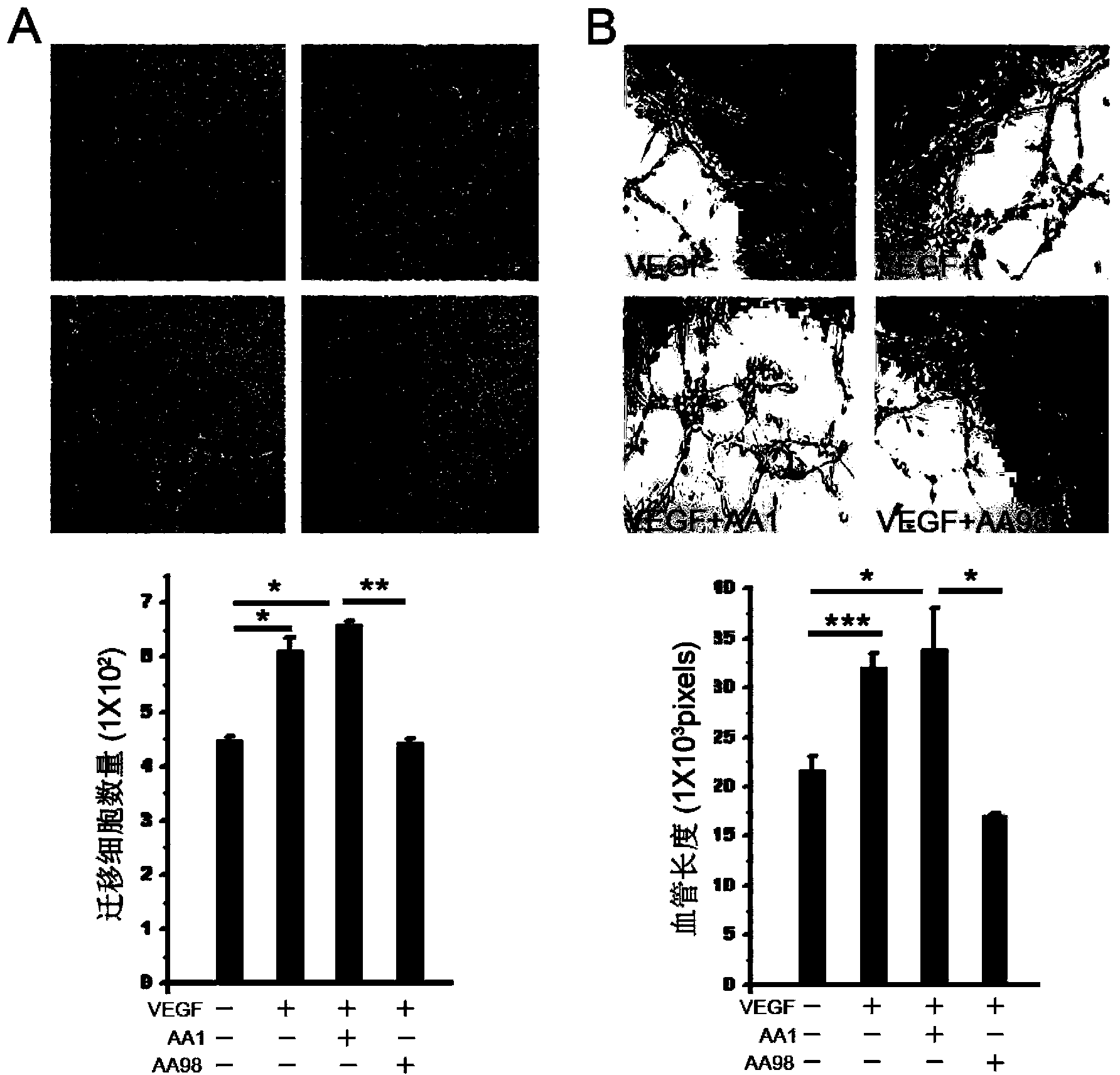Application of novel function of CD146 targeted as co-receptor of vascular endothelial growth factor receptor-2 (VEGFR-2) in anti-tumor angiogenesis treatment
A tumor blood vessel and tumor technology, applied in the field of tumor treatment, can solve the problems of inability to completely kill tumor cells, inability to achieve therapeutic effects, and recurrence of remaining cells.
- Summary
- Abstract
- Description
- Claims
- Application Information
AI Technical Summary
Problems solved by technology
Method used
Image
Examples
Embodiment 1
[0023] Example 1: Interaction between CD146 and VEGFR-2 at the cellular level;
[0024] Both CD146 and VEGFR-2 are markers of endothelial cells and are key molecules in the process of angiogenesis, but their connection is not clear. In order to study the relationship between the two, we confirmed the interaction between CD146 and VEGFR-2 at the cellular level by co-immunoprecipitation and other methods. Anti-CD146 monoclonal antibody AA98 can block the interaction between CD146 and VEGFR-2.
[0025] Main materials: human umbilical vein endothelial cell line (HUVECs) (ATCC, CRL-1730), HEK293T cell line stably transfected with CD146cDNA (ATCC, CRL-11268) (HEK293T / CD146), etc.
[0026]Main reagents: cell lysate, PBS, mouse-derived anti-CD146 monoclonal antibody AA1 (produced by our laboratory independently. Preservation institution: China General Microbiology Collection Center; preservation number: CGMCC No.2310; preservation date: 2007.12.28), rabbit Anti-VEGFR-2 antibody (pur...
Embodiment 2
[0043] Example 2: The anti-CD146 antibody blocks the activation of the VEGFR-2 signaling pathway caused by VEGF stimulation by blocking the interaction between CD146 and VEGFR-2;
[0044] The adhesion molecule CD146 has a key role in angiogenesis. As a co-receptor of VEGFR-2, CD146 regulates the VEGFR-2 signaling pathway. Anti-CD146 monoclonal antibody AA98 can block the interaction between CD146 and VEGFR-2, thereby blocking the activation of VEGFR-2 signaling pathway induced by VEGF stimulation.
[0045] Incubate HUVECs with anti-CD146 monoclonal antibody AA98 or AA1 (100μg / ml), and after 1 hour at 37°C, wash with cell culture medium three times, then stimulate with VEGF (50ng / ml) and lyse the cells for biochemical analysis path. Such as figure 2 (A) As shown in HUVECs, AA98 can block the interaction between endogenous CD146 and VEGFR-2. As shown in (B-F), VEGF stimulation (5 minutes) can cause the phosphorylation of VEGFR-2, as well as the activation of downstream sign...
Embodiment 3
[0046] Example 3: Anti-CD146 antibody inhibits endothelial cell migration and angiogenesis induced by VEGF stimulation;
[0047] Angiogenesis mainly provides nutrients for tumors and provides pathways for tumor cell metastasis, so it plays a vital role in tumor growth. Inhibition of angiogenesis can inhibit tumor growth to a great extent. VEGF is the main cytokine secreted by tumor cells, and the signaling pathway mediated by it ultimately determines tumor angiogenesis. CD146 participates in and regulates VEGF-VEGFR-2 signaling pathway, and anti-CD146 antibody inhibits the migration and angiogenesis of endothelial cells stimulated by VEGF.
[0048] Main materials: human umbilical vein endothelial cell line, 96-well Transwell plate (Corning HTS Transwell-96 Cell Migration Products), etc.
[0049] Main reagents: VEGF (purchased from Upstate Biotechnology, Cat. No. B500014), anti-CD146 antibodies AA98 and AA1, mouse IgG (mIgG, purchased from Sigma-Aldrich, Cat. No. I5381), Matr...
PUM
 Login to View More
Login to View More Abstract
Description
Claims
Application Information
 Login to View More
Login to View More - R&D
- Intellectual Property
- Life Sciences
- Materials
- Tech Scout
- Unparalleled Data Quality
- Higher Quality Content
- 60% Fewer Hallucinations
Browse by: Latest US Patents, China's latest patents, Technical Efficacy Thesaurus, Application Domain, Technology Topic, Popular Technical Reports.
© 2025 PatSnap. All rights reserved.Legal|Privacy policy|Modern Slavery Act Transparency Statement|Sitemap|About US| Contact US: help@patsnap.com



